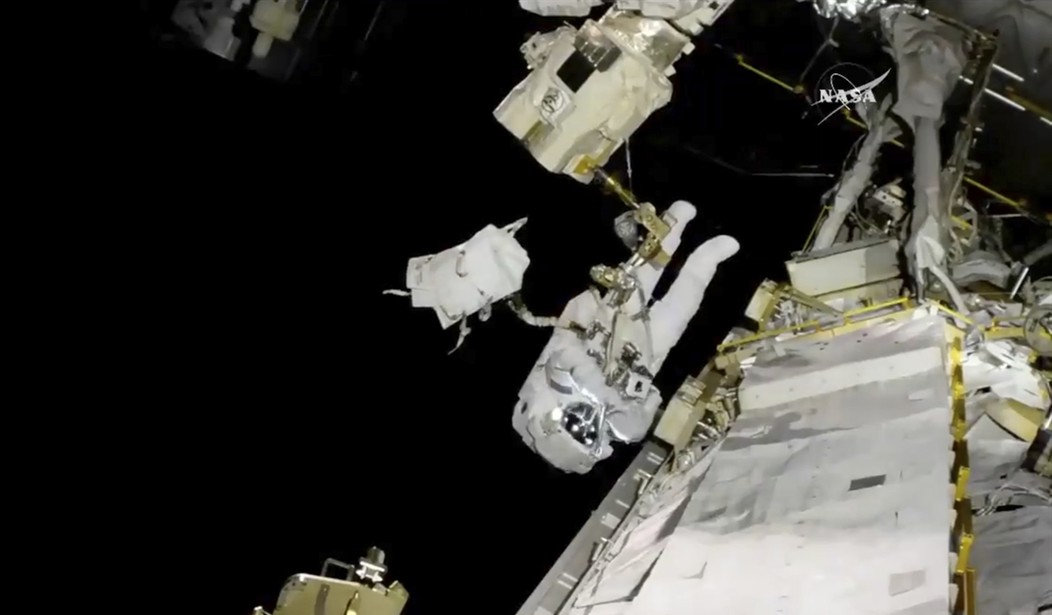On the evening of April 14, 1912, when the RMS Titanic struck an iceberg on its maiden voyage to New York, the world suddenly changed for many people. The ship had been carefully divided into socioeconomic classes, with the ultrawealthy dining on caviar and vintage wines in sumptuous feast halls and the poorest dregs of society scraping for crusts of bread in steerage. As reality gradually sunk in and the passengers realized that the ship was going down and no help was on the way, those class-based barriers largely evaporated. With the exception of a few callow, upper-class passengers, the scant lifeboats were filled with women and children of all societal ranks with the wealthy awaiting their inevitable fate alongside the poorest of the poor. Many wealthy people were lost, including John Jacob Astor IV, who would be a billionaire several times over in today's money. The North Atlantic does not accept bribes.
I bring this up in the context of today's scheduled spacewalks by multiple billionaires aboard SpaceX's Polaris Dawn mission. One of those is Jared Isaacman, the founder of Draken International. Isaacman is worth roughly the same as John Jacob Astor IV was, adjusted for inflation. These billionaires aren't going to be doing any scientific work of significance while they take a brief stroll in space. In fact, they will barely be outside the spacecraft and will be attached to the Crew Dragon by umbilical cords the entire time. They are tourists and nothing more, and they are paying a massive fee for the privilege of doing this. But what they are doing remains incredibly dangerous by any standard of measurement you choose to apply. Rather than advancing man's scientific knowledge and propelling us further toward the stars, is commercial spaceflight turning into a death-defying hobby reserved for the extremely wealthy? (CBS News)
Billionaire Jared Isaacman and SpaceX crew trainer Sarah Gillis plan to open the forward hatch of their Polaris Dawn spacecraft early Thursday to take turns floating outside in the first non-government spacewalk in the history of space exploration.
With crewmates Anna Menon and Scott Poteet monitoring safety tethers and umbilicals inside the SpaceX Crew Dragon capsule, Isaacman and Gillis plan to float out into open space after depressurizing the spacecraft around 2:23 a.m. EDT, using a scaffold-like "Skywalker" assembly extending from the hatch for stability.
While their feet will be just outside the hatch, they will not "free float" away from the Crew Dragon. Their SpaceX-designed pressure suits are not equipped with their own oxygen supply or other life support equipment and rely on the 12-foot-long umbilicals to deliver air, power and communications.
Looked at from a distance, a spacewalk probably appears to be one of the most thrilling recreational events imaginable. I'm sure that's true. But we should also remember that going into low Earth orbit in any fashion is an inherently dangerous activity. Stepping outside the capsule compounds the danger. Some of you may recall that in 2013, Italian Astronaut Luca Parmitano was on a spacewalk when his suit suddenly began filling with water. He was soon unable to see or even breathe and he was in a place where removing his helmet would have spelled instant death. Most of us can scarcely imagine such a horrific scenario. Thankfully, the rest of the crew was able to pull him back inside and save him, but it was a very close call.
It was no accident that I first referenced the sinking of the Titanic in this article. A little more than a year ago, the submersible Titan lost control while attempting to dive on the wreck, eventually falling below crush depth and imploding. That was also a tourist outing for billionaires, but it ended disastrously. We seem to be observing a new trend in tourism that is exclusively available to the ultra-wealthy. But all of it potentially comes with a horrific price to pay. Whether you are gasping for your final breath in the blackness of space or sitting in your submersible awaiting the inevitable implosion, those are some of the more gnarly ways to meet your maker imaginable. The people involved are paying princely sums for the privilege of risking everything in that fashion and sucking vast amounts of capital out of the system while doing so.
There was a time when the only guys going into space (and let's be honest, they were almost exclusively men) were hardened test pilots who had survived the worst conditions imaginable in craft that were frequently dubious at best in terms of safety and reliability. If something goes seriously wrong under those conditions, these were the people you wanted at the controls. They knew that every trip might be their last and they accepted the risks in an effort to make history. Now we're selling these seats to the highest bidder or to celebrities for promotional reasons. (We sent William Shatner into orbit at 90 years of age when the entirety of his previous experience had been on a television production set.) Is all of this space tourism and deep sea tourism really advancing man's scientific endeavors? Or are we simply cheapening the entire experience in the pursuit of greater and greater luxuries for the wealthy?









Join the conversation as a VIP Member